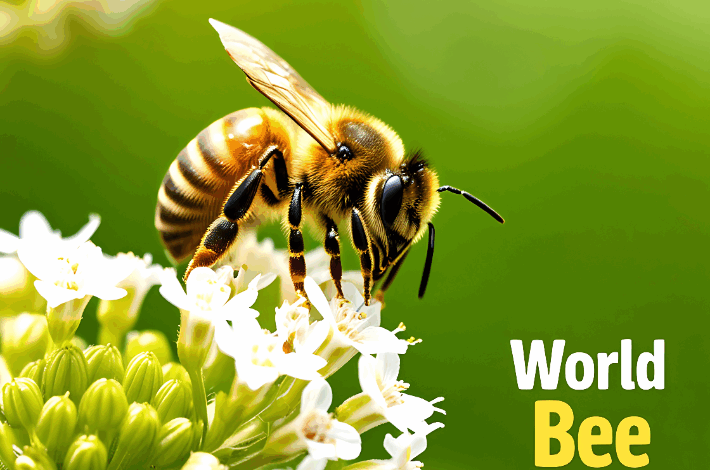
World Bee Day is celebrated on May 20 every year. The United Nations established it in 2017 to raise awareness of the importance of bees and other pollinators for the health of ecosystems and food security.
History of World Bee Day
World Bee Day is celebrated on May 20 yearly to raise awareness about the importance of bees and other pollinators in maintaining healthy ecosystems and ensuring food security. Slovenia, a country with a strong beekeeping tradition, initiated the idea for this day.
It honors the birthday of Anton Janša, a pioneer of modern beekeeping who was born on May 20, 1734. Janša was one of the first beekeeping teachers in the Habsburg Monarchy and was known for his deep understanding of bee behavior and the importance of bees to agriculture.
In 2016, Slovenia proposed the idea of World Bee Day to the United Nations, gaining support from the Food and Agriculture Organization (FAO), Apimondia (the International Federation of Beekeepers’ Associations), and several member states.
The proposal emphasized bees’ critical role in pollinating plants, supporting biodiversity, and sustaining food systems. On December 20, 2017, the United Nations General Assembly officially declared May 20 World Bee Day, and the first celebration was held in 2018. The day is now recognized globally as a time to promote actions that protect pollinators and preserve their habitats.
The Vital Role of Bees in Our World
Bees play an essential role in sustaining life on Earth through their work as pollinators. They are responsible for pollinating approximately 75% of the world’s food crops, including many fruits, vegetables, nuts, and seeds that comprise a significant portion of our diets. Without bees, the availability and diversity of our food would decline sharply, affecting both human nutrition and global food security.
Beyond food production, bees are key contributors to biodiversity and ecosystem health. By pollinating a wide variety of plants, they support the growth of trees, flowers, and other vegetation that provide food and shelter for countless animal species. This process helps maintain fertile soil, balance natural habitats, and ensure the stability of ecosystems. In short, the survival of many other species—including our own—is closely tied to the well-being of bees.
Threats to Bees
Bees face various serious threats that are putting their populations at risk worldwide. One major threat is the widespread use of pesticides, especially neonicotinoids, which can impair bees’ ability to navigate, forage, and reproduce.
These chemicals are often used in industrial agriculture and have harmful effects even in small doses. Alongside this, climate change disrupts natural flowering cycles and weather patterns, making it harder for bees to find consistent food sources throughout the year.
Another significant issue is habitat loss due to urban development, intensive farming, and deforestation. As wildflowers and nesting areas disappear, bees struggle to survive and thrive. In addition, bees are also threatened by diseases and invasive species.
Parasites like the Varroa mite and pathogens such as Nosema weaken bee colonies, while invasive species like the Asian hornet prey on native bees, further reducing their numbers. These factors create a challenging environment for bees, ultimately threatening global biodiversity and food security.
What you can do
- Plant bee-friendly flowers and herbs like lavender, sunflowers, and thyme.
- Avoid using harmful pesticides.
- Support local beekeepers and buy raw local honey.
- Spread awareness about the importance of pollinators.
How to Celebrate World Bee Day
Celebrating World Bee Day on May 20 can be fun, educational, and impactful—whether you’re an individual, a teacher, a parent, or part of a community group. Here are some creative and meaningful ways to join the buzz:
1. Plant Bee-Friendly Flowers
- Grow native, nectar-rich plants like lavender, sunflowers, marigolds, or wildflowers.
- Choose a variety that blooms in different seasons to provide year-round food for pollinators.
2. Support Local Beekeepers
- Buy local honey and other bee products like beeswax candles, propolis, and pollen.
- Visit a local farmer’s market or a nearby apiary to learn more about their work.
3. Get Creative with Kids
- Make bee crafts: paper bees, honeycomb art, or recycled bee houses.
- Organize bee-themed games, storytime, or coloring activities.
- Watch documentaries like “More Than Honey” or “Bee Movie” (for younger audiences).
4. Educate and Spread Awareness
- Share facts about bees on social media with hashtags like #WorldBeeDay and #SaveTheBees.
- Host or attend a bee talk, workshop, or webinar about pollinators and biodiversity.
- Invite a local beekeeper to speak at your school or community center.
5. Go Chemical-Free
- Avoid pesticides and herbicides in your garden.
- Encourage friends and neighbors to use organic gardening methods.
6. Build a Bee Hotel
- Create a safe space for solitary bees (like mason bees) by building or buying a bee hotel.
- Hang it in a sunny, sheltered spot.
7. Shop Sustainably
- Buy products made using sustainable, bee-friendly practices.
- Look for organic and pollinator-safe certifications on foods and cosmetics.
8. Join or Host a Local Event
- Many parks, botanical gardens, and nature centers host World Bee Day events.
- Check online or on social media for events near you—or start one yourself!
Enjoy some jokes about bees.
1. Where did Noah keep his bees?
In the ark hives
2. My wife got stung by a bee on the forehead. She’s at the ER now, her face all swollen and bruised, she almost died.
Luckily I was close enough to hit the bee with my shovel.
3. Male bees die after mating. So that’s basically their life.
Honey. Nut. Cheerio.
4. My boyfriend started a bee farm to help save the bees
I think he’s a keeper
5. What do you call a Bee hive with no exits? Unbelievable.
Stepdads, Support for Stepdads is just a tap away! We’re excited to introduce the mobile version of our trusted site, offering the same wealth of resources, expert advice, and community connection as our desktop site —now optimized for your phone or tablet. Whether you’re seeking tips on bonding with stepchildren, navigating co-parenting, or finding encouragement from others who understand, this mobile site ensures help is always at your fingertips. Accessible anytime, anywhere, Support for Stepdads is your go-to resource for thriving in your unique role. Empower your journey today —your family will thank you!





